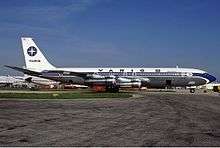Varig Flight 820
 A Varig Boeing 707-379C similar to the one involved in the accident | |
| Occurrence summary | |
|---|---|
| Date | 11 July 1973 |
| Summary | In-flight fire |
| Site | near Orly, France |
| Passengers | 117 |
| Crew | 17 |
| Fatalities | 123 |
| Injuries (non-fatal) | 11 |
| Survivors | 11 |
| Aircraft type | Boeing 707-320C |
| Operator | Varig |
| Registration | PP-VJZ |
| Flight origin | Galeão International Airport |
| Destination | Orly Airport |
Varig Flight 820 was a scheduled international passenger flight from Galeão Airport, Rio de Janeiro, Brazil to Orly Airport, Paris, France. On 11 July 1973, the Boeing 707 made an emergency landing in a field in Saulx-les-Chartreux, a commune located about 5 km south of the destination airport, due to smoke in the cabin. The fire, smoke, and crash at the final part of the landing resulted in 123 deaths, with 11 survivors (10 crew, 1 passenger).
Crash
Flight 820's problems began when a fire started in a rear lavatory. Crew members moved to the front of the airplane toward the emergency exit, as many passengers in the body of the plane inhaled smoke. Prior to the forced landing, many of the passengers had already died of smoke inhalation. The aircraft landed at a field 5 km short of the runway, in a full-flap and gear down configuration.
Only one passenger survived, while the major part of the crew left the plane by the emergency exit at the top of the cockpit. The captain of this flight, Gilberto Araujo da Silva, disappeared 30 January 1979 while flying Varig Cargo Boeing 707 PP-VLU over the Pacific Ocean.[1]
A possible cause of the fire was that the lavatory waste bin contents caught fire after a still lit cigarette was thrown into it, the FAA issued AD 74-08-09 requiring "installation of placards prohibiting smoking in the lavatory and disposal of cigarettes in the lavatory waste receptacles; establishment of a procedure to announce to airplane occupants that smoking is prohibited in the lavatories; installation of ashtrays at certain locations; and repetitive inspections to ensure that lavatory waste receptacle doors operate correctly".
Aircraft
The aircraft involved was a Boeing 707-345C, serial number 19841. It was the 683rd Boeing 707 produced,[2] and was delivered new to Seaboard World Airlines under registration N7322S on 6 March 1968.[3] The plane was sold to Varig and delivered as PP-VJZ on 31 March 1969.[2] The jet was powered by four Pratt & Whitney JT3D-3B engines.[4]
Passengers
Most of the passengers on the aircraft were Brazilian. The only survivors were in the cockpit and the first several rows of seats. Of the 11 survivors, 10 were members of the crew.[5]
Notable passengers who died included:
- Jörg Bruder, Olympic sailor
- Filinto Müller, President of the Senate of Brazil[5]
- Agostinho dos Santos, singer
- Antonio Carlos Scavone, TV Globo journalist, Formula 3 driver, and the person responsible for bringing Formula 1 to Brazil.
- José Joe Baxter, Argentinian revolutionary, militant of the People's Revolutionary Army.
- Júlio Delamare, sports journalist
See also
References
- ↑ Germano da Silva, Carlos Ari César (2008). "No céu de Paris". O rastro da bruxa: história da aviação comercial brasileira no século XX através dos seus acidentes 1928–1996 (in Portuguese) (2 ed.). Porto Alegre: EDIPUCRS. pp. 285–290. ISBN 978-85-7430-760-2.
- 1 2 "Aircraft construction & line number". airframes.org. Retrieved 10 June 2014.
- ↑ "Aircraft data". airframes.org. Retrieved 10 June 2014.
- ↑ "Background description of the Boeing 707 family". boeing.com. Archived from the original on 6 October 2013. Retrieved 27 December 2013.
- 1 2 "Death in the Air: Fire and Fumes." Time. 23 July 1973. Retrieved on 8 December 2010.(subscription required)
Further reading
- "Varig 707 had toilet fire." Flight International. 17 April 1976. p. 995.
External links
|
|
- Accident description at the Aviation Safety Network
- FAA Airworthiness Directive regarding placarding
- (French) Official report of the inquiry commission of the French secretariat of transportation (Archive)